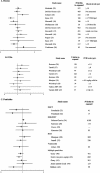Can environmental or occupational hazards alter the sex ratio at birth? A systematic review
- PMID: 24149027
- PMCID: PMC3168220
- DOI: 10.3402/ehtj.v4i0.7109
Can environmental or occupational hazards alter the sex ratio at birth? A systematic review
Abstract
More than 100 studies have examined whether environmental or occupational exposures of parents affect the sex ratio of their offspring at birth. For this review, we searched Medline and Web of Science using the terms 'sex ratio at birth' and 'sex ratio and exposure' for all dates, and reviewed bibliographies of relevant studies to find additional articles. This review focuses on exposures that have been the subject of at least four studies including polychlorinated biphenyls (PCBs), dioxins, pesticides, lead and other metals, radiation, boron, and g-forces. For paternal exposures, only dioxins and PCBs were consistently associated with sex ratios higher or lower than the expected 1.06. Dioxins were associated with a decreased proportion of male births, whereas PCBs were associated with an increased proportion of male births. There was limited evidence for a decrease in the proportion of male births after paternal exposure to DBCP, lead, methylmercury, non-ionizing radiation, ionizing radiation treatment for childhood cancer, boron, or g-forces. Few studies have found higher or lower sex ratios associated with maternal exposures. Studies in humans and animals have found a reduction in the number of male births associated with lower male fertility, but the mechanism by which environmental hazards might change the sex ratio has not yet been established.
Keywords: PCBs; boron; dioxins; environmental; g-forces; metals; occupational; pesticides; radiation; sex ratio.
Figures



Similar articles
-
Environmental hazards: evidence for effects on child health.J Toxicol Environ Health B Crit Rev. 2007 Jan-Mar;10(1-2):3-39. doi: 10.1080/10937400601034563. J Toxicol Environ Health B Crit Rev. 2007. PMID: 18074303 Review.
-
Polychlorinated biphenyls (PCBs) in relation to secondary sex ratio--a systematic review of published studies.Chemosphere. 2013 Apr;91(2):131-8. doi: 10.1016/j.chemosphere.2012.11.019. Epub 2012 Dec 20. Chemosphere. 2013. PMID: 23260246 Review.
-
Environmental factors associated with a spectrum of neurodevelopmental deficits.Ment Retard Dev Disabil Res Rev. 2002;8(3):188-97. doi: 10.1002/mrdd.10033. Ment Retard Dev Disabil Res Rev. 2002. PMID: 12216063 Review.
-
Epidemiologic evidence of relationships between reproductive and child health outcomes and environmental chemical contaminants.J Toxicol Environ Health B Crit Rev. 2008 May;11(5-6):373-517. doi: 10.1080/10937400801921320. J Toxicol Environ Health B Crit Rev. 2008. PMID: 18470797 Review.
-
Environmental exposure to polychlorinated biphenyls (PCBs) and dioxins. Consequences for longterm neurological and cognitive development of the child lactation.Adv Exp Med Biol. 2000;478:271-87. Adv Exp Med Biol. 2000. PMID: 11065080 Review.
Cited by
-
Effects of dioxins on animal spermatogenesis: A state-of-the-art review.Front Reprod Health. 2022 Oct 21;4:1009090. doi: 10.3389/frph.2022.1009090. eCollection 2022. Front Reprod Health. 2022. PMID: 36339774 Free PMC article. Review.
-
Male frequency in Caenorhabditis elegans increases in response to chronic irradiation.Evol Appl. 2022 Sep 2;15(9):1331-1343. doi: 10.1111/eva.13420. eCollection 2022 Sep. Evol Appl. 2022. PMID: 36187185 Free PMC article.
-
Association between occupational testicular radiation exposure and lower male sex ratio of offspring among orthopedic surgeons.PLoS One. 2021 Dec 31;16(12):e0262089. doi: 10.1371/journal.pone.0262089. eCollection 2021. PLoS One. 2021. PMID: 34972186 Free PMC article.
-
A Unifying Theory for Autism: The Pathogenetic Triad as a Theoretical Framework.Front Psychiatry. 2021 Nov 16;12:767075. doi: 10.3389/fpsyt.2021.767075. eCollection 2021. Front Psychiatry. 2021. PMID: 34867553 Free PMC article.
-
Observable variations in human sex ratio at birth.PLoS Comput Biol. 2021 Dec 2;17(12):e1009586. doi: 10.1371/journal.pcbi.1009586. eCollection 2021 Dec. PLoS Comput Biol. 2021. PMID: 34855745 Free PMC article.
References
-
- Marcus M, Kiely J, Xu F, McGeehin M, Jackson R, Sinks T. Changing sex ratio in the United States, 1969–1995. Fertil Steril. 1998;70:270–3. - PubMed
-
- Mathews TJ, Hamilton BE. Trend analysis of the sex ratio at birth in the United States. Natl Health Stat Report. 2005;53:1–17. - PubMed
-
- Agresti A, Coull BA. Approximate is better than ‘exact’ for interval estimation of binomial proportions. Am Statistician. 1998;52:119–26.
-
- Vollset SE. Confidence intervals for a binomial proportion. Stat Med. 1993;12:809–24. - PubMed
-
- Chang BL, Robbins WA, Wei F, Xun L, Wu G, Li N, et al. Boron workers in China: Exploring work and lifestyle factors related to boron exposure. AAOHN J. 2006;54:435–43. - PubMed
Grants and funding
LinkOut - more resources
Full Text Sources

